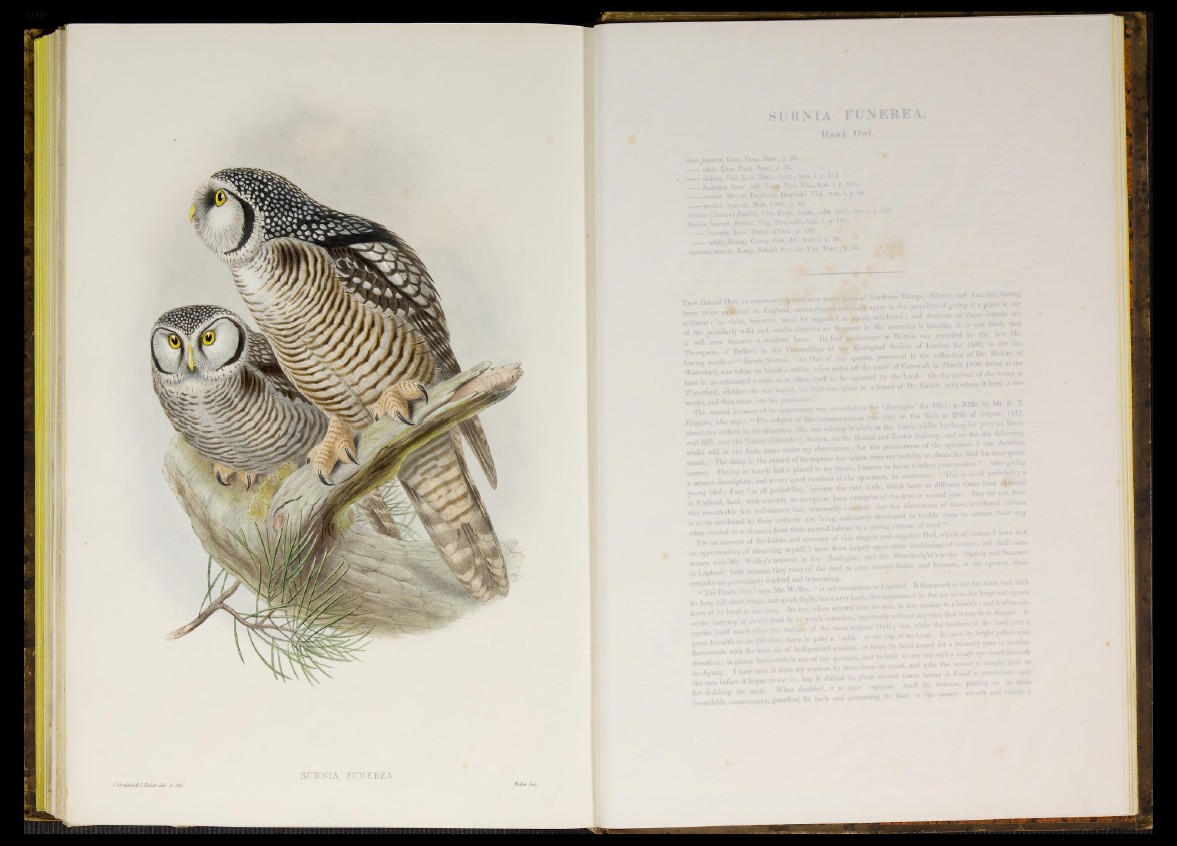
SURNIA FUNEREA.
Hawk Owl.
Strix funerea, Linn. Faun. Su.ec.,-p. 25.
iilula, Linn. Faun. Suec., p. 26.
_ doliata, Pall. Zool. Ross.-Asiat., torn. i. p, 316. '
hudsottia, Gtnel. edit. T.n\n, Syst N a t, tom. i. p. 396.
_ _ nisoria, Meyer, TsscHenh. DeutschL Yog., tom. i. p; 84
Noctua (Surnia) funerea, Cuv. Bhgn. Anim., edit. 1817, tom.
Surma funerea, Brebm, Vog. Deutachl., tom. i. p. 101,
borealis, Less. Traiti. d’Orn., p. 100.
ulttla, Bouap. Consp. Gen. A?., tom. i. p- 36.
Symium nisoria, Kanp, Naturl. Sys. der Eur. Thier.,% 59.
T h i s diurnal Owl,
been twice c á p u
, commonly spread over many port, o f Northern Europe. Siberia, and America, hnvmg
1 in Enelan?, ornithologists geiibrallv agree in the propriety of gm n g it a place to oar
however, must be regarded as purely accidental; and destitute as these islands are
o f the peculiarly wild, and waT r a c k e d 'b y ^ h e ' U .e Mr.
|s° i f e : “5 , • <« funerea’ An Owl of this species, preserved in the collection of u r. tu rn « ,
lowing words S u rm a /m e o f Cornwall, in March 1830, being a t the
Waterford, was taken on board a collier, a tew miles oh m e g
time in so exhausted a state as to allow
Waterford, whither she was bound, ih*
weeks, and then came into his possession.
The second instance of its appearance was i
Higgins, who says: “ The subject o f this
about two o’clock in the afternoon (the so
well Hill, near the Yatton (Clcvedon) Station, on rt
whilst still in the flesh, came under my obscrratioi
vouch. The delay in the record of its capture has
itured by e h an d . On th e a rrival o f th e vea
>f Dr. B irk itt, with whom it lived
is recorded
immunicati
, the ’ Zoologist’ for 1851. p. 3029. by Mr. E. T.
wls shot on the 25tli or 26th o f August, 1847,
itlv a t the time), whilst hawking for prey on Back-
: l>i istol and Exeter Railway, and on the day following,
; for the genuineness of the specimen I can therefor
»risen from my inability to obtain the bird for description
“ This
ueiav iu i w w. — — r - . , -
sooner. Having a t length had It placed in my hands, I hasten to brmg . before y
a minute description, and a very good woodcut o f the spec,men, " H ’
young b ird ; I s a , -in all probability,’ beeanse the rare bjrds, wh.eh have a t d.lferent
in England, have, with seareely an exception; been examples
this remarkable but well-known fact, reasonably conclude t
is to be attributed to their instincts not being sufficient!;
when carried to a distance from their natural habitat by a .
For an account of the habits and economy of this clegs
of observing myself, I must draw largely
Wolley’s account iu the ‘ Zoologist,’ at
Aftei
[ probé
de
».first or second y
e occurrence of t
>ed to Suable the
nrrent o f wind ?”
lingular CM, whii
her ornithological
o opporti iffht’s
se they treat of the bird as s
truthful and interesting.
iys Mr. Wolley, “ is not uncom
i, and quick flight, has a very ha
seen. Its cry, when uttered i
¿gad fir to watch intruders,
the fashion o f the more r e
I face, there is quite a ‘ table
llc a ir of half-puzzled wisdom,
in Laplaw i 1m
remarks a
“ TheHawk O w l" s a j
its long tail, short wings,
form o f its head is I
on the bare top of a»
great breadth to its fall
downwards with the tr#
direction ; to glance bac
its dignity. I have seen
the tree before it began
fr»«* finishing- the meal.
mfds is out o f the question
t from my window fly down
i eat i t ; but it shifted its
When disabled, it at one
and
a in Lapland. I t flies much in the day-time,
■like appearance in the air when the large a
r its nest, is also similar to a hawk’s ; and il
uthout any idea that it can be in di
• but, while the feathers at the b.
■ of its head. I t casts its bright y
s head round for a leisurely gaze :
k a t any one with a single eye mm
and, and take the mouse it cm
si times before it found a cm
’ itself for defence, putting on
I Owls